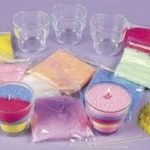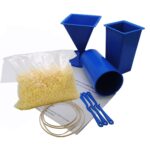Candle making has long been a popular craft, cherished for its soothing ambiance and delightful scents. But beyond its therapeutic benefits, many people wonder if there is any money to be made in the business of candle making. In this article, we will delve into the profitability of this craft, taking a closer look at the booming candle industry and its market segment.
The fascination with candle making goes far beyond just a simple hobby. With an increasing interest in handmade and artisanal products, homemade candles have gained momentum in recent years. Consumers are seeking unique and personalized items that align with their individual tastes and preferences. This growing demand presents a promising opportunity for entrepreneurs to enter the candle market.
To fully understand the potential profitability of candle making, it is important to explore various aspects of this craft. We will examine the initial investments and ongoing expenses involved in setting up a candle-making business, as well as estimating profit margins. Furthermore, by identifying niche opportunities and employing effective marketing strategies, candle makers can maximize their sales potential.
Throughout this article, we will present real-life success stories and case studies from experienced candle makers who have achieved profitable ventures in the industry. By learning from their strategies and insights, aspiring entrepreneurs can gain valuable knowledge to apply to their own candle making journey.
Join us as we unravel the world of candle making profitability and discover whether this craft holds enticing financial prospects or remains simply a passion pursued for personal enjoyment.
The Allure of Homemade Candles
The allure of homemade candles has grown significantly in recent years, thanks to evolving consumer preferences and the rise of the handmade and artisanal trends. Consumers are increasingly drawn to unique, locally-made products that offer a personal touch and support small businesses. This shift in consumer behavior has created a growing demand for homemade candles.
One of the main benefits of homemade candles over commercial alternatives is the quality and customization they offer. Homemade candle makers have the freedom to experiment with different scents, colors, shapes, and designs, creating one-of-a-kind products that cannot be found in mass-produced candles. This customization allows consumers to find candles that align with their personal preferences and create a special ambiance in their homes.
Statistics and market insights further validate the increasing demand for unique candles. According to a report by Grand View Research, the global candle market is expected to reach USD 6.76 billion by 2025, with a compound annual growth rate of 3.8%.
The same report also highlights a growing interest in specialty candles such as scented and decorative varieties. As consumers become more conscious about creating a cozy and inviting atmosphere at home, they turn to these unique handmade candles as a way to express their individuality.
Exploring the Costs
In order to start a candle making business, it is important to understand the costs involved in both the initial investments and ongoing expenses. This section will delve into the equipment needed for candle making, sourcing quality ingredients and materials, as well as estimating ongoing expenses for packaging, marketing, and other operational costs.
Firstly, let’s analyze the costs associated with the necessary equipment for candle making. The initial investment for equipment can vary depending on the scale of your operation and the types of candles you intend to produce.
At a minimum, you will need a melting pot for wax, thermometers to monitor temperatures, molds or containers to shape your candles, as well as utensils for stirring and pouring. It is also worth considering investing in additional tools such as wick holders or pouring pitchers to improve efficiency and consistency in your production process.
Next, let’s discuss sourcing quality ingredients and materials. The cost of these supplies can also vary based on factors such as the type of wax you choose (e.g., soy wax, beeswax), fragrance oils or essential oils for scenting your candles, wicks, colorants if desired, and any additional decorative elements. It is important to research different suppliers to ensure you are getting competitive prices without compromising on quality.
Furthermore, it is essential to estimate ongoing expenses such as packaging, marketing, and other operational costs. Packaging options can range from simple labels or wrapping to more elaborate designs depending on your brand aesthetic. Additionally, marketing expenses may include creating a website or online store platform, social media advertising campaigns or collaborations with influencers in the industry. Other operational costs may include utilities such as electricity or gas used during production, transportation costs if applicable, and general overhead expenses.
| Cost | Details |
|---|---|
| Equipment | Melting pot, thermometers, molds/containers, utensils, wick holders, pouring pitchers |
| Ingredients and Materials | Wax, fragrance oils/essential oils, wicks, colorants, decorative elements |
| Packaging | Labels/wrapping materials, designing and printing packaging materials |
| Marketing | Website creation/maintenance, social media advertising/collaborations |
| Operational Costs | Utilities (electricity/gas), transportation costs, general overhead expenses |
By thoroughly analyzing the costs involved in both initial investments and ongoing expenses, candle makers can have a better understanding of the financial implications of starting and running a candle making business. This knowledge will enable them to make informed decisions when it comes to pricing their products and managing their overall profitability.
Estimating Profit Margins
Profit margins play a crucial role in determining the financial viability of any business, including candle making. In this section, we will explore how to calculate profit margins for candle making, strategies for pricing your candles, and the impact of different sales channels on profitability.
To begin with, calculating the cost per candle is essential in determining your profit margins. This involves analyzing not only the cost of materials used but also labor and overhead expenses. By accurately estimating these costs, you can set appropriate prices that ensure profitability while remaining competitive in the market.
In terms of materials, it’s important to consider both quality and cost-effectiveness. Sourcing high-quality ingredients and materials may involve higher initial investment but can lead to better customer satisfaction and potentially higher prices for your candles. Comparing prices and suppliers can help you find a balance between quality and affordability.
| Expense | Cost Range |
|---|---|
| Equipment | $100 – $500+ |
| Raw Materials (wax, wicks, fragrance oils) | $50 – $200 |
| Packaging | $0.25 – $1 per unit |
| Marketing | Varies depending on strategy |
Once you have determined your costs, pricing strategies come into play. Finding the sweet spot between affordability for customers and profitability for your business is important. Conducting market research to understand what consumers are willing to pay for unique candles will help inform your pricing decisions.
Furthermore, different sales channels can have an impact on your profit margins. Selling directly to consumers through your own website or at local markets allows you to maximize profits as there are no middlemen involved. However, wholesale partnerships or consignment arrangements may offer the opportunity to reach a wider customer base, albeit with lower profit margins due to the discount offered to retailers.
By taking into account these factors and carefully calculating profit margins, candle makers can determine the financial viability of their business and make informed decisions regarding pricing and sales strategies. In the next section, we will explore niche opportunities within the candle market and how they can further enhance profitability.
Identifying Niche Opportunities
In the highly competitive candle industry, finding a unique market segment can be the key to success. By identifying niche opportunities, candle makers can tap into specific consumer preferences and stand out from the crowd. In this section, we will explore how to analyze candle market trends, identify gaps, and position your brand effectively.
One of the first steps in identifying niche opportunities is analyzing the current candle market trends. Understanding what consumers are looking for can help you find untapped areas where your handmade candles can thrive. Keep an eye on emerging trends such as personalized candles, scented candles with unique fragrances, or eco-friendly candles made from sustainable materials. Conducting market research and staying up-to-date with industry news and consumer preferences will give you valuable insights into potential niche markets.
Once you have identified a few potential niche markets, it’s important to evaluate their profitability and demand. Consider factors such as competition, target audience size, and pricing dynamics within each segment. For example, if you are considering personalized candles, research whether there is enough demand for customized products and if customers are willing to pay a premium for them. Understanding the landscape of each potential market segment will help you make informed decisions about which ones to pursue.
Competitive analysis is another crucial aspect of identifying niche opportunities. Study your competitors in each potential niche market and look for ways to differentiate yourself from them. Consider elements such as product offerings, branding strategies, packaging designs, and pricing structures. By understanding what your competitors are doing well and where they might be falling short, you can position your brand in a way that fills those gaps and meets unfulfilled customer needs.
By identifying niche opportunities within the candle industry and finding your unique market segment, you can carve out a profitable space for yourself in this booming business. Analyzing current candle market trends, evaluating profitability within different segments, and conducting competitive analysis will lay the foundation for success. In the next section, we will discuss strategies to effectively market and brand your candles to boost sales within your chosen niche.
Marketing and Branding
Marketing and branding are crucial elements for any business, including candle making. In this section, we will explore the strategies that candle makers can employ to boost sales and create a strong brand presence in the market.
Building an Engaging Brand
One of the first steps to boosting sales is building a brand that resonates with target customers. Think about what sets your candles apart from others in the market and use that as a foundation for your brand identity. Consider factors such as the type of candles you make (e.g., scented, personalized), the materials you use, and your unique selling proposition.
Effective Marketing Techniques
In today’s digital age, having a strong online presence is essential for marketing your candle business. Create a website where potential customers can find information about your products, your story, and how to purchase them. Utilize social media platforms like Instagram or Facebook to showcase visually appealing images of your candles and engage with customers.
Collaborations with influencers or other businesses can also be a powerful marketing tool. Partnering with lifestyle bloggers or local stores can help increase exposure for your brand and bring in new customers.
Leveraging on storytelling and creating a unique value proposition
Storytelling is an important aspect of effective marketing in the candle industry. Share the story behind your brand, why you started making candles, and what makes your products special. Emphasize the benefits and emotions associated with using handmade candles, such as relaxation, ambiance, or self-care.
Creating a unique value proposition is another crucial element of successful marketing. This could include offering limited edition candles, custom branding options for special occasions like weddings or corporate events, or packaging that reflects sustainable values.
Overall, implementing these marketing strategies and focusing on building a strong brand will help boost sales for your candle making business. By effectively reaching out to potential customers through engaging storytelling and leveraging online platforms, you can create awareness and demand for your unique candles.
Scaling and Expanding
Scaling up production: deciding when and how to increase volume
One of the key factors in maximizing profit potential in candle making is knowing when and how to scale up production. As demand for your homemade candles grows, it may become necessary to increase your production volume to meet customer needs and expand your business. However, scaling up should be done strategically to ensure profitability.
When deciding to scale up production, it’s important to consider factors such as your current market demand, available resources, and capacity. Conducting market research can help you identify if there is sufficient demand for increased volumes of your candles. This can be done through surveys or analyzing sales data.
In terms of how to increase volume, there are a few options to consider. You could invest in more equipment or machinery that allows you to produce more candles at a faster rate. Alternatively, you may choose to outsource some production steps or even hire additional staff members to help with manufacturing tasks. Each option has its own associated costs and considerations, so it is important to carefully evaluate which approach aligns best with your business goals and financial situation.
Potential diversification opportunities (e.g., candle accessories, home fragrances)
Expanding your product offerings beyond just candles can also contribute to maximizing profit potential in the candle making industry. By diversifying into related products such as candle accessories or home fragrances, you can cater to a wider range of customer preferences and increase your overall revenue.
Candle accessories encompass items such as candle holders, decorative containers, or wick trimmers. These complementary products not only enhance the visual appeal of the candles but also provide customers with additional options for personalization and customization.
Home fragrances are another avenue for diversification that can boost profits. This could include diffusers, room sprays, or wax melts that complement the scents of your candles. By offering a variety of home fragrance options, you can appeal to customers who may prefer alternative methods of scenting their living spaces.
Before diversifying your product range, it is essential to conduct market research and assess the demand for these additional offerings. Understanding your target market and their preferences will help inform your decisions on which products to introduce and how they can contribute to maximizing profit potential.
Expanding sales channels: wholesale, consignment, partnerships, and beyond
Expanding your sales channels is an effective way to increase your reach and maximize profit potential in candle making. While selling directly to consumers through your own website or physical store is undeniable helpful, exploring other avenues can open up new opportunities for growth.
One option is to consider selling your candles wholesale. This involves partnering with retailers who purchase your products in bulk at a discounted rate and then resell them in their stores. This allows you to reach a wider customer base through established retail networks without the need for extensive marketing efforts on your part.
Another avenue for expanding sales channels is through consignment agreements with boutiques or gift shops. In this model, you provide inventory to the retailer who only pays you when the products are sold. Consignment arrangements can be mutually beneficial as they allow retailers to offer unique homemade candles while minimizing their inventory risk.
Partnerships with complementary businesses can also be advantageous. Collaborating with local artisans or wellness brands for cross-promotion or creating gift sets can help expand your customer base and increase brand visibility.
Overall, by exploring different sales channels, you can tap into new markets and increase profitability by reaching customers who may not have otherwise discovered your homemade candles.
Success Stories
The Power of Branding: The Success Story of “Scented Serenity”
One shining example of a profitable candle business is “Scented Serenity,” a brand that has made significant waves in the industry. The success of this brand can be attributed to their strong focus on branding and storytelling. By creating a unique value proposition centered around relaxation and self-care, Scented Serenity has managed to carve out a loyal customer base.
Scented Serenity’s candles are hand-poured using high-quality ingredients and infused with carefully curated scents that transport customers to peaceful havens. By leveraging an engaging online presence through social media platforms, they have successfully connected with their target audience and built a community around their brand. Collaborations with influencers and wellness experts have further solidified their positioning as a go-to brand for luxury candles.
Innovative Differentiation: How “Whimsical Waxworks” Made Their Mark
Another inspiring success story comes from the creative minds behind “Whimsical Waxworks.” This entrepreneurial duo saw an opportunity in the market for personalized candles and capitalized on it brilliantly. Offering customizable options such as scent choices, colors, and even customized labels, they quickly carved out a niche for themselves.
By understanding their target market’s desire for unique, personalized products, Whimsical Waxworks created a loyal following who were willing to pay a premium for their one-of-a-kind candles. Online marketing played a crucial role in their success as they effectively utilized social media platforms to showcase the endless possibilities of customization. Additionally, collaborations with wedding planners and event organizers helped them expand into the lucrative wedding favors market.
Scaling Up Successfully: From Kitchen Table to Production Facility – The Journey of “Ambrosia Aromas”
One exceptional story of scaling up is exemplified by “Ambrosia Aromas,” a candle business that started as a small operation run out of a home kitchen but eventually grew into a full-fledged production facility. What set Ambrosia Aromas apart was their dedication to consistently producing high-quality candles that appealed to diverse customer preferences.
As the demand for their products grew, Ambrosia Aromas made strategic investments in equipment and infrastructure to meet the increased volume. They also expanded their product line to include complementary items such as reed diffusers and scented wax melts. By focusing on wholesale partnerships with boutique stores and establishing an online presence, Ambrosia Aromas successfully scaled up their business while maintaining profitability.
These success stories demonstrate that candle making can indeed be a profitable venture if approached strategically. However, it is important to adapt these strategies to your own unique brand and market segment. By learning from these examples, aspiring candle makers can gain valuable insights into different approaches for building and growing a profitable candle business.
Conclusion
In conclusion, the question of whether candle making is a profitable venture can be answered with a resounding yes. Throughout this article, we have explored the various aspects of the candle industry and analyzed its potential for profitability. The booming market segment, evolving consumer preferences, and increasing demand for unique handmade candles all contribute to the viability of this craft as a profitable business opportunity.
However, it is important to recognize that success in candle making requires more than just financial calculations. Passion, dedication, and continuous improvement are essential factors that can drive the profitability of your candle business. By understanding current market trends, identifying niche opportunities, and positioning your brand effectively, you can maximize your profit potential.
Additionally, marketing strategies and effective branding techniques play a crucial role in boosting sales. Building an engaging brand, establishing an online presence through social media platforms, and leveraging storytelling can help create a unique value proposition that resonates with target customers. These efforts will not only increase your visibility but also enhance customer loyalty and ultimately contribute to your bottom line.
Moreover, scaling up production and exploring diversification opportunities such as candle accessories or home fragrances can further maximize profit potential. By expanding sales channels through wholesale agreements, consignment partnerships or collaborations with other businesses in related industries, you can broaden your customer reach and generate additional revenue streams.
So if you have been contemplating turning your love for candle making into a profitable venture – now is the perfect time to take action.
Frequently Asked Questions
How profitable is making candles?
The profitability of making candles can vary depending on various factors. Generally, candles can be a profitable venture if approached with the right strategies and market demand. To maximize profits, it is crucial to carefully consider aspects such as product differentiation, target audience, pricing, marketing techniques, and operational efficiency.
Additionally, keeping production costs controlled by sourcing materials economically and optimizing manufacturing processes can contribute to overall profitability. By analyzing the market dynamics and continuously innovating with new candle designs or scents that appeal to consumers, one can increase the chances of running a profitable candle-making business.
Is homemade candle a good business?
Homemade candles have the potential to be a good business opportunity for those who are passionate about crafting and creating unique products. There are several advantages to starting a homemade candle business: lower start-up costs compared to larger-scale production facilities, ability to work from home, flexibility in terms of working hours and product customization, and the charm associated with handcrafted items that often attracts buyers.
However, it’s essential to acknowledge certain challenges as well when starting a homemade candle business. These may include establishing a consistent customer base, maintaining quality control during production at smaller scales, ensuring efficient distribution channels, and competing against established brands in the market.
Can you make money selling handmade candles?
Yes, it is possible to make money selling handmade candles; however, success relies on several variables that go beyond just creating beautiful candles. Selling handmade candles successfully requires understanding your target audience and tailoring your product offering accordingly. It’s necessary to identify unique selling points or niches within the candle market that differentiate your handmade creations from mass-produced alternatives available commercially.
Building strong branding through professional packaging and effective marketing can also contribute significantly towards attracting customers willing to pay a premium for handmade goods. Moreover, developing an online presence through e-commerce platforms or social media channels offers opportunities for reaching broader markets beyond local customers – thereby increasing sales potential and profit margins in selling handmade candles.

Welcome to my candle making blog! In this blog, I will be sharing my tips and tricks for making candles. I will also be sharing some of my favorite recipes.





